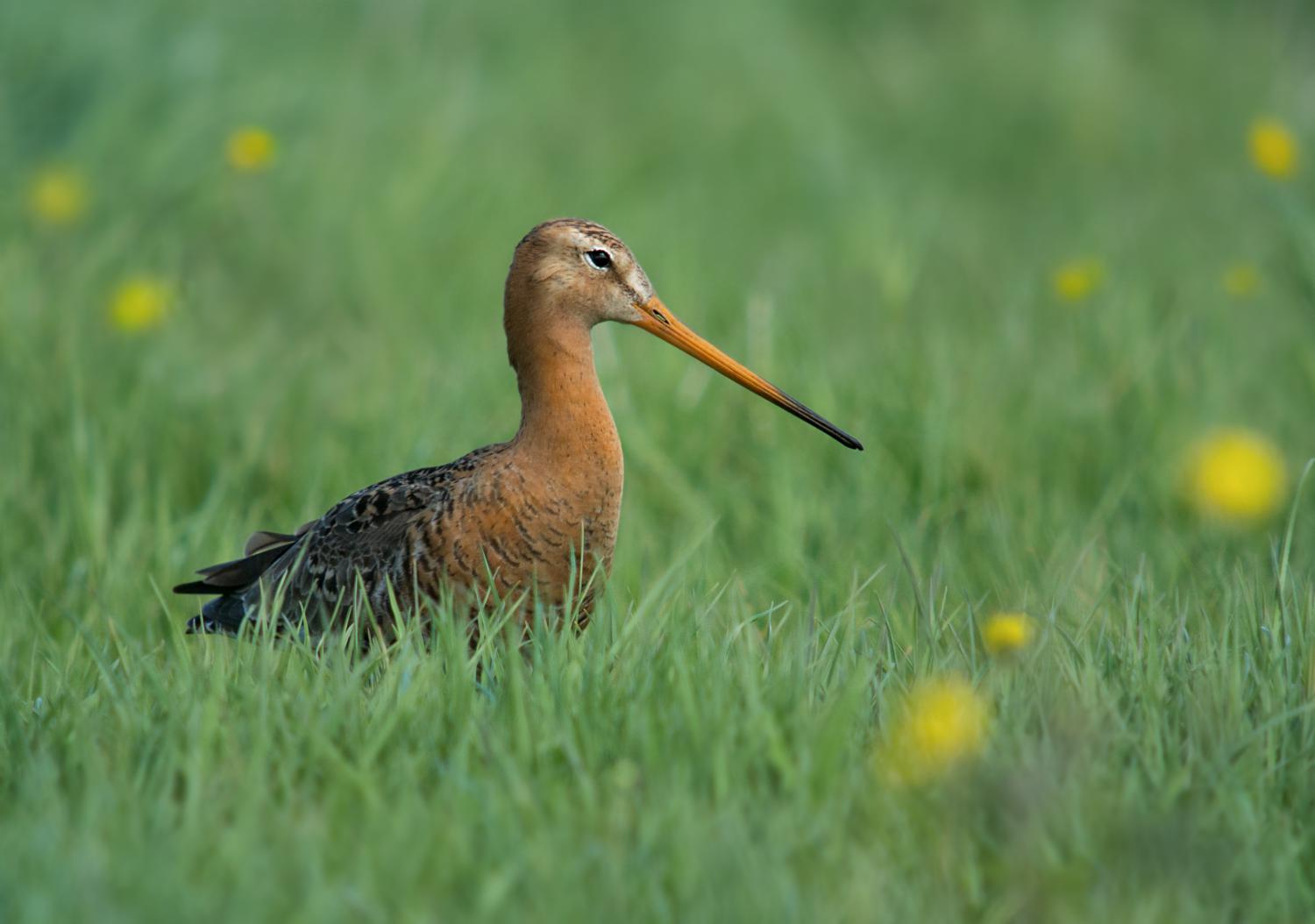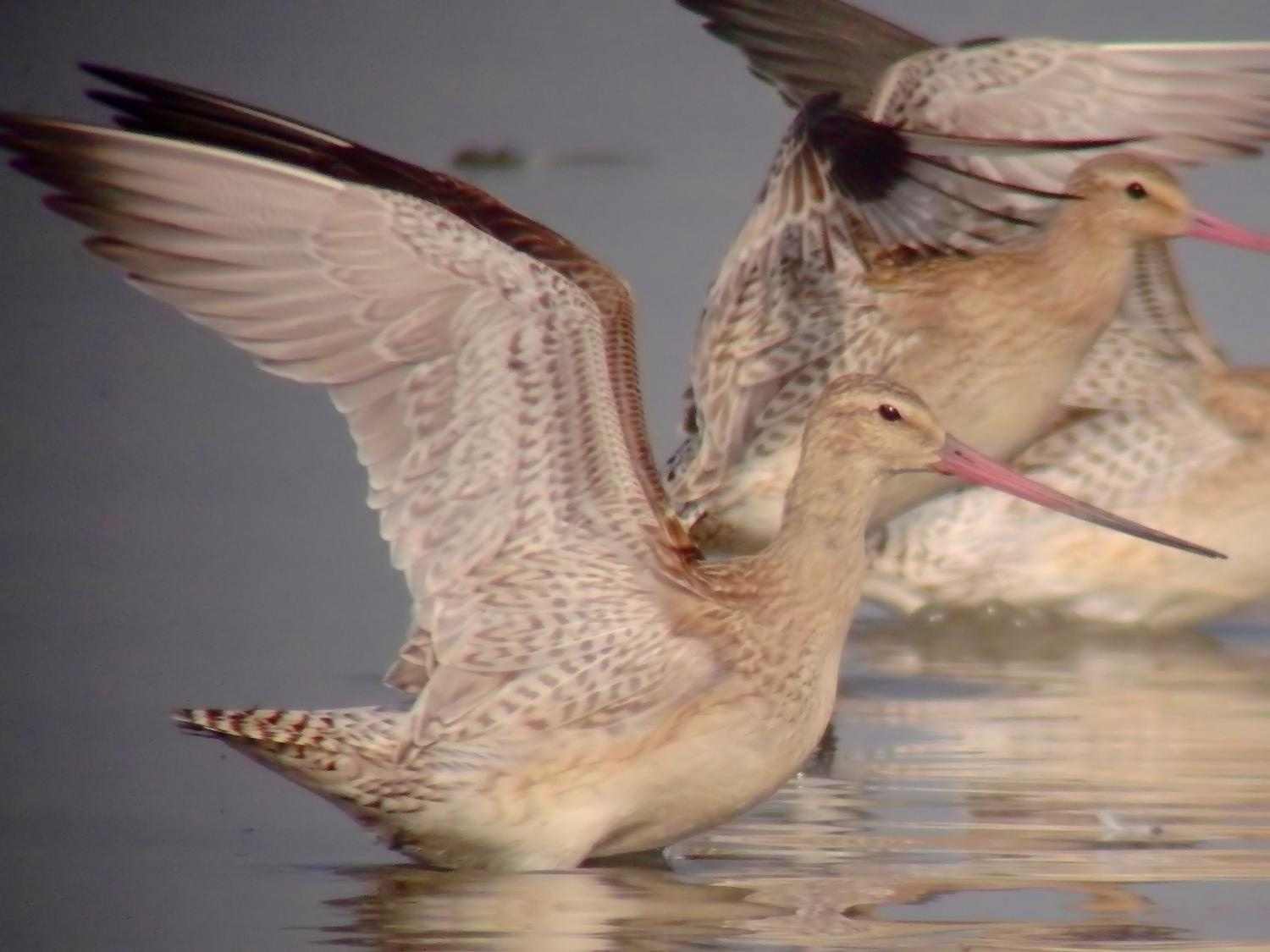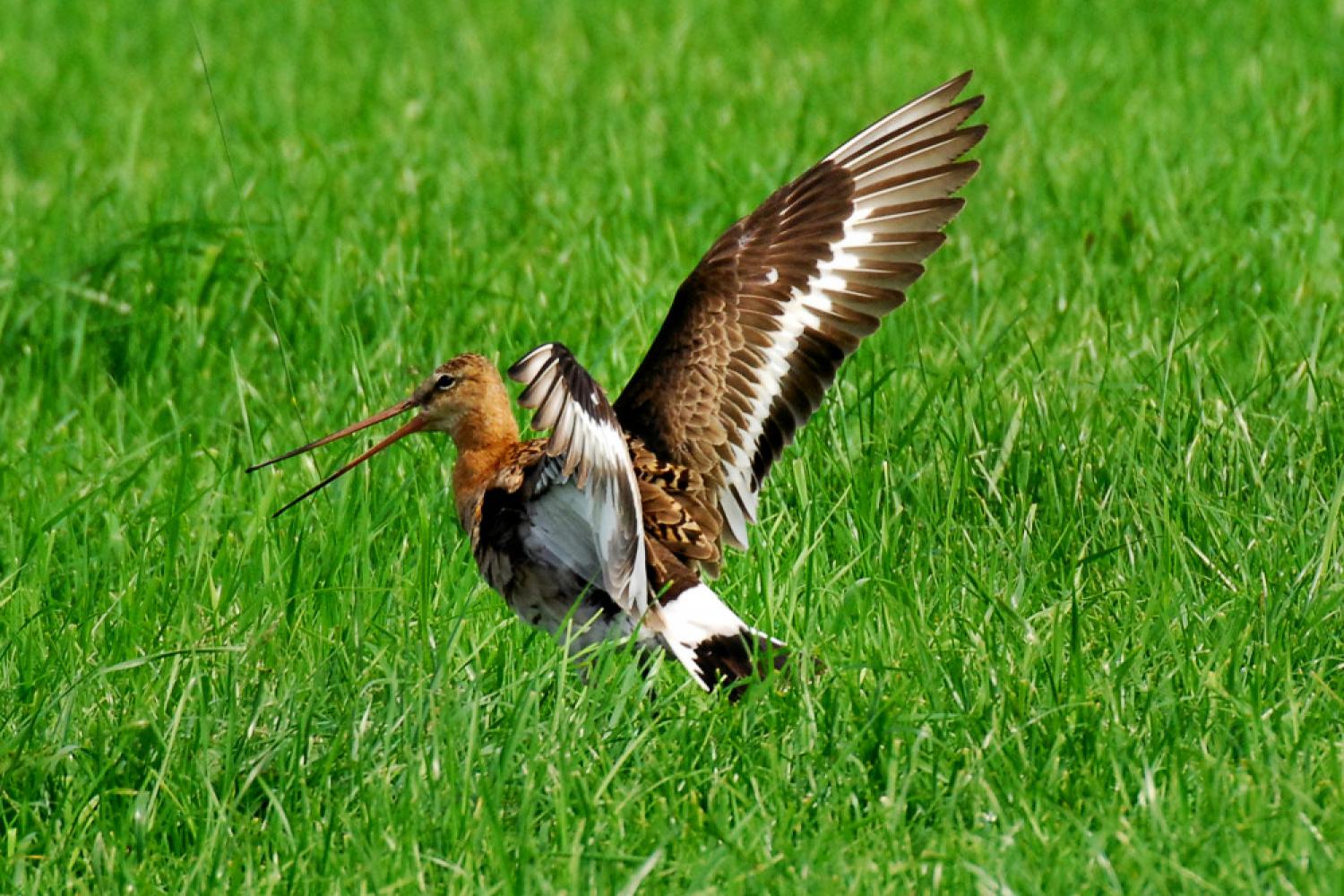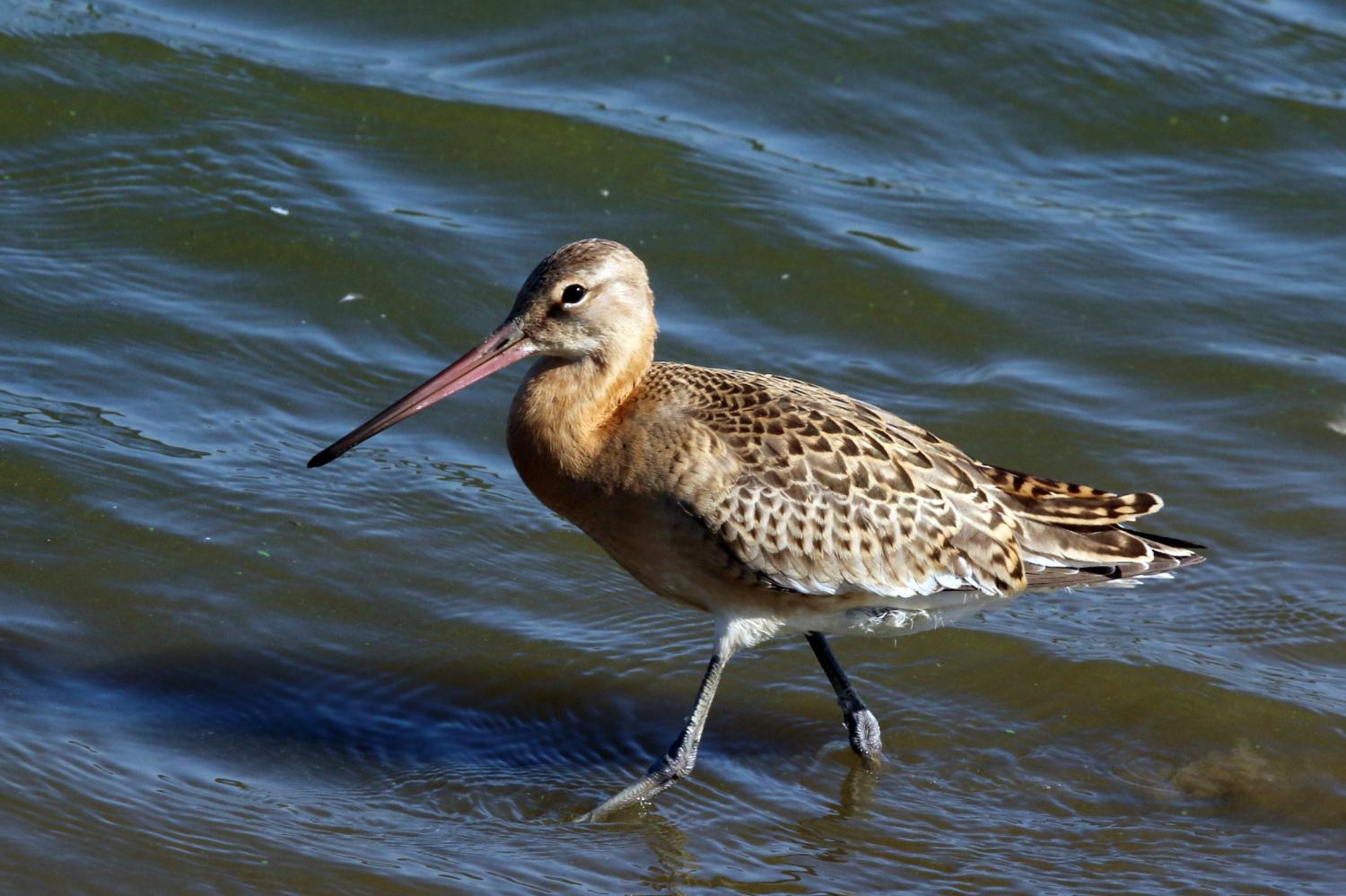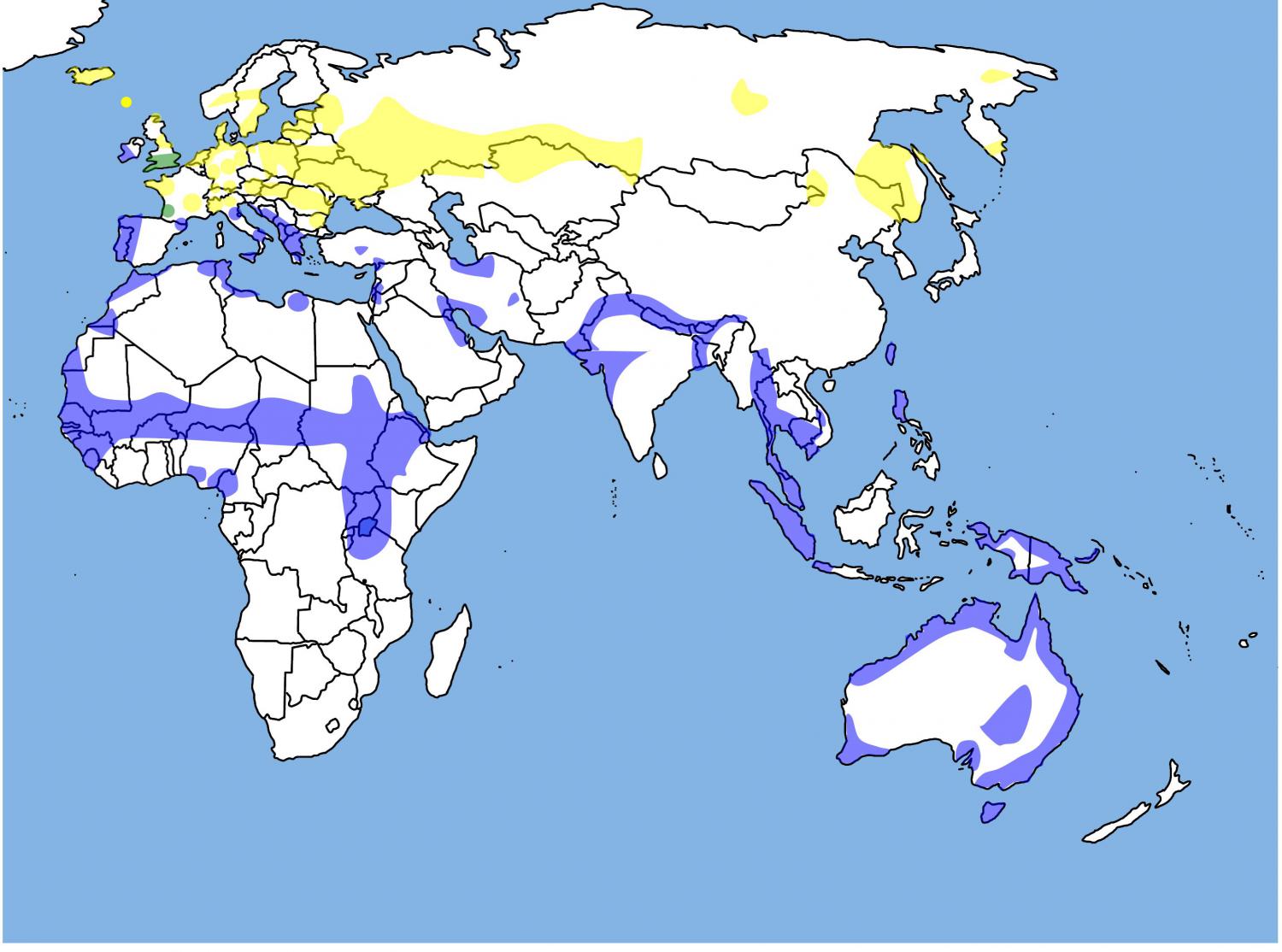Species of Thailand
Black-tailed godwit
Limosa limosa
Carolus Linnaeus, 1758
In Thai: นกปากแอ่นหางดำ
The black-tailed godwit (Limosa limosa) is a large, long-legged, long-billed shorebird first described by Carl Linnaeus in 1758. It is a member of the godwit genus, Limosa. There are three subspecies, all with orange head, neck and chest in breeding plumage and dull grey-brown winter coloration, and distinctive black and white wingbar at all times.
Its breeding range stretches from Iceland through Europe and areas of central Asia. Black-tailed godwits spend (the northern hemisphere) winter in areas as diverse as the Indian Subcontinent, Australia, New Zealand, western Europe and west Africa. The species breeds in fens, lake edges, damp meadows, moorlands and bogs and uses estuaries, swamps and floods in (the northern hemisphere) winter; it is more likely to be found inland and on freshwater than the similar bar-tailed godwit. The world population is estimated to be 634, 000 to 805, 000 birds and is classified as Near Threatened. The black-tailed godwit is the national bird of the Netherlands
Taxonomy
This species was first described, as Scolopax limosa, by Carl Linnaeus in 1758. Its scientific name is derived from Latin and means "muddy", from limus, "mud". The English name was first recorded in about 1416–17 and is believed to imitate the bird's call.
The black-tailed godwit is a member of the genus Limosa (godwits), family Scolopacidae (sandpipers) and order Charadriiformes, the waders. There are three subspecies:
- L. l. limosa – (Linnaeus, 1758): the European black-tailed godwit, which breeds from western and central Europe to central Asia and Asiatic Russia, as far east as the Yenisei River. Its head, neck and chest are pale orange.
- L. l. islandica – Brehm, 1831: the Icelandic black-tailed godwit, which breeds mostly in Iceland, but also on the Faeroe Islands, Shetland and the Lofoten Islands. It has a shorter bill, shorter legs and more rufous coloration extending onto the belly, compared to limosa.
- L. l. melanuroides – Gould, 1846: the Asian black-tailed godwit, which breeds in Mongolia, northern China, Siberia and far eastern Russia. Its plumage is similar to islandica, but the bird is distinctly smaller.
Description
The black-tailed godwit is a large wader with long bill (7.5 to 12 cm long), neck and legs. During the breeding season, the bill has a yellowish or orange-pink base and dark tip; the base is pink in winter. The legs are dark grey, brown or black. The sexes are similar, but in breeding plumage, they can be separated by the male's brighter, more extensive orange breast, neck and head. In winter, adult black-tailed godwits have a uniform brown-grey breast and upperparts (in contrast to the bar-tailed godwit's streaked back). Juveniles have a pale orange wash to the neck and breast.
In flight, its bold black and white wings and white rump can be seen readily. When on the ground it can be difficult to separate from the similar Bar-tailed Godwit, but the black-tailed godwit's longer, straighter bill and longer legs are diagnostic. Black-tailed godwits are similar in body size and shape to bar-taileds, but stand taller.
It measures 42 cm from bill to tail with a wingspan of 70 – 82 cm. Males weigh around 280 g and females 340 g. The female is around 5% larger than the male, with a bill 12–15% longer.
The most common call is a strident weeka weeka weeka.
A study of black-tailed godwits in the Netherlands found a mortality rate of 37.6% in the first year of life, 32% in the second year, and 36.9% thereafter.
Distribution and habitat
Black-tailed godwits have a discontinuous breeding range stretching from Iceland to the far east of Russia. Their breeding habitat is river valley fens, floods at the edges of large lakes, damp steppes, raised bogs and moorlands. An important proportion of the European population now uses secondary habitats: lowland wet grasslands, coastal grazing marshes, pastures, wet areas near fishponds or sewage works, and saline lagoons. Breeding can also take place in sugar beet, potato and rye fields in the Netherlands and Germany.
In spring, black-tailed godwits feed largely in grasslands, moving to muddy estuaries after breeding and for winter. On African wintering grounds, swamps, floods and irrigated paddy fields can attract flocks of birds. In India, inland pools, lakes and marshes are used, and occasionally brackish lakes, tidal creeks and estuaries.
Godwits from the Icelandic population winter mainly in the United Kingdom, Ireland, France and the Netherlands, though some fly on to Spain, Portugal and perhaps Morocco. Birds of the limosa subspecies from western Europe fly south to Morocco and then on to Senegal and Guinea-Bissau. Birds from the eastern European populations migrate to Tunisia and Algeria, then on to Mali or Chad. Young birds from the European populations stay on in Africa after their first winter and return to Europe at the age of two years. Asian black-tailed godwits winter in Australia, Taiwan, the Philippines, Indonesia, and Papua New Guinea.
Black-tailed godwits are much more likely to be found on inland wetlands than the more coastal bar-tailed godwit. They migrate in flocks to western Europe, Africa, south Asia and Australia. Although this species occurs in Ireland and Great Britain all year-round, they are not the same birds. The breeding birds depart in autumn, but are replaced in winter by the larger Icelandic race. These birds occasionally appear in the Aleutian Islands and, rarely, on the Atlantic coast of North America.
There is an estimated global population of between 634, 000 and 805, 000 birds and estimated range of 7, 180, 000 km2. In 2006 BirdLife International classified this species as Near Threatened due to a decline in numbers of around 25% in the previous 15 years. It is also among the species to which the Agreement on the Conservation of African-Eurasian Migratory Waterbirds (AEWA) applies.
Breeding
Black-tailed godwits are mostly monogamous; although it was not recorded in a four-year study of 50–60 pairs, bigamy was considered "probably frequent". A study of the Icelandic population showed that despite spending winter apart, pairs are reunited on their breeding grounds within an average of three days of each other. If one partner does not arrive on time, 'divorce' occurs. They nest in loose colonies. Unpaired males defend a temporary territory and perform display flights to attract a mate. Several nest scrapes are made away from the courtship territory, and are defended from other godwits. Once eggs are laid, an area of 30 – 50 m around the nest is defended. The nest is a shallow scrape on the ground, usually in short vegetation. The eggs may be hidden with vegetation by the incubating parent.
The single brood of three to six eggs, coloured olive-green to dark brown, measure 55 x 37 mm and weigh 39 g each (of which 6% is shell). Incubation lasts 22–24 days and is performed by both parents. The young are downy and precocial and are brooded while they are small and at night during colder weather. After hatching, they are led away from the nest and may move to habitats such as sewage farms, lake edges, marshes and mudflats. The chicks fledge after 25–30 days.
Black-tailed godwit productivity varies, positively, with spring temperatures. However, during extreme events, such as a volcanic eruption, complete breeding failures can occur.
Food and feeding
They mainly eat invertebrates, but also aquatic plants in winter and on migration. In the breeding season, prey includes beetles, flies, grasshoppers, dragonflies, mayflies, caterpillars, annelid worms and molluscs. Occasionally, fish eggs, frogspawn and tadpoles are eaten. In water, the most common feeding method is to probe vigorously, up to 36 times per minute, and often with the head completely submerged. On land, black-tailed godwits probe into soft ground and also pick prey items from the surface.
Relationship to humans
In Europe, black-tailed godwits are only hunted in France, with the annual total killed estimated at 6, 000 to 8, 000 birds. This puts additional pressure on the western European population, and the European Commission has a management plan in place for the species in its member states. In England, black-tailed godwits were formerly much prized for the table. Sir Thomas Browne (1605–1682) said: " were accounted the daintiest dish in England and I think, for the bignesse, of the biggest price." Old names included Blackwit, Whelp, Yarwhelp, Shrieker, Barker and Jadreka Snipe. The Icelandic name for the species is Jaðrakan.
This article uses material from Wikipedia released under the Creative Commons Attribution-Share-Alike Licence 3.0. Eventual photos shown in this page may or may not be from Wikipedia, please see the license details for photos in photo by-lines.
Category / Seasonal Status
Wiki listed status (concerning Thai population): Winter visitor
BCST Category: Recorded in an apparently wild state within the last 50 years
BCST Seasonal status: Non-breeding visitor
Scientific classification
- Kingdom
- Animalia
- Phylum
- Chordata
- Class
- Aves
- Order
- Charadriiformes
- Family
- Scolopacidae
- Genus
- Limosa
- Species
- Limosa limosa
Common names
- English: Black-tailed godwit
- French: Barge à queue noire
- Thai: นกปากแอ่นหางดำ
Subspecies
Limosa limosa islandica, Christian Ludwig Brehm, 1831
Common name: Icelandic black-tailed godwit
Range: Iceland, but also on the Faeroe Islands, Shetland and the Lofoten Islands. It has a shorter bill, shorter legs and more rufous coloration extending onto the belly, compared to limosa.
Limosa limosa limosa, Carolus Linnaeus, 1758
Common name: Asian black-tailed godwit
Range: Mongolia, northern China, Siberia and far eastern Russia. Its plumage is similar to islandica, but the bird is distinctly smaller.
Limosa limosa melanuroides, John Gould, 1846
Common name: European black-tailed godwit
Range: From western and central Europe to central Asia and Asiatic Russia, as far east as the Yenisei River. Its head, neck and chest are pale orange.
Synonyms
- Scolopax limosa, Carolus Linnaeus (1758)
Conservation status

Near Threatened (IUCN3.1)

Near Threatened (BirdLife)

Near Threatened (ONEP)

Near Threatened (BCST)
Photos
Please help us review the bird photos if wrong ones are used. We can be reached via our contact us page.
Range Map
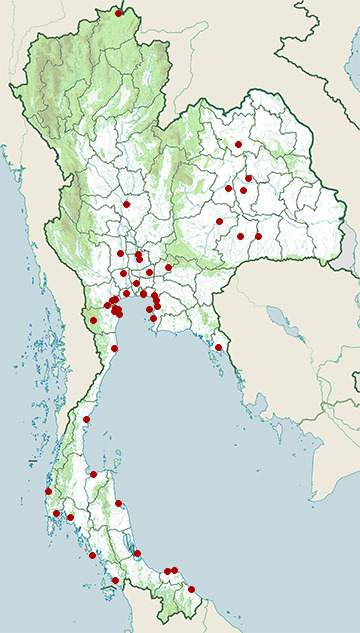
- Amphawa District, Samut Songkhram
- Ao Phang-Nga National Park
- Ban Laem District, Phetchaburi
- Ban Phai District, Khon Kaen
- Bang Lamung District, Chonburi
- Bang Len District, Nakhon Pathom
- Bang Pahan District, Phra Nakhon Si Ayutthaya
- Bang Pakong District, Chachoengsao
- Bang Phra Non-Hunting Area
- Bang Pu Recreation Centre
- Bangkok Province
- Borabue District, Maha Sarakham
- Bueng Boraped Non-Hunting Area
- Chumphon Coast
- Huai Chorakhe Mak Reservoir Non-Hunting Area
- Kaeng Krachan National Park
- Kantharawichai District, Maha Sarakham
- Khao Sam Roi Yot National Park
- Khao Yoi District, Phetchaburi
- Ko Libong
- Ko Sichang District, Chonburi
- Kumphawapi District, Udon Thani
- Laem Pak Bia
- Mueang Chonburi District, Chonburi
- Mueang Krabi District, Krabi
- Mueang Pattani District, Pattani
- Mueang Phetchaburi District, Phetchaburi
- Mueang Samut Sakhon District, Samut Sakhon
- Mueang Samut Songkhram District, Samut Songkhram
- Mueang Suphanburi District, Suphan Buri
- Mueang Surin District, Surin
- Mueang Trat District, Trat
- Nakhon Si Thammarat Coast
- Narathiwat Coast
- Nong Bong Khai Non-Hunting Area
- Pak Phli District, Nakhon Nayok
- Pak Thale
- Pattani Coast
- Phimai District, Nakhon Ratchasima
- Phra Nakhon Si Ayutthaya District, Phra Nakhon Si Ayutthaya
- Samut Prakan Province
- Satun Coast
- Songkhla Coast
- Surat Thani Coast
- Takua Pa District, Phang Nga
- Thanyaburi District, Pathum Thani
